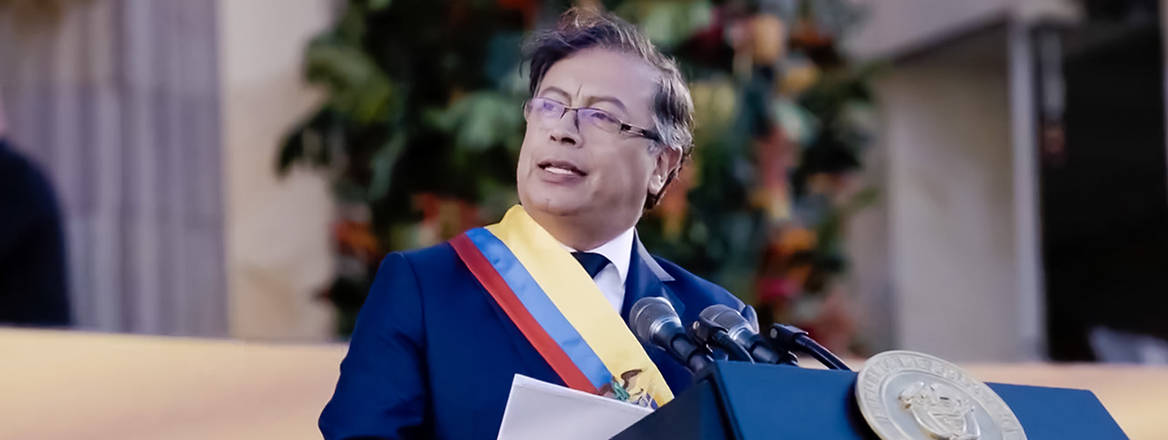Is Colombia About to Turn its Back on the ‘War on Drugs’?
Colombia’s new president has indicated his desire to take a different approach to tackling the cocaine trade, as its associated harms continue to mount.
The cocaine market presents a clear global threat, from production chains in South America to large consumer markets in the Americas and Europe. It is a global trade which, according to new Colombian President Gustavo Petro – himself a former guerrilla – has killed a million Latin Americans over 40 years, left 70,000 North Americans dead every year from overdoses, and strengthened the mafias while debilitating countries and evaporating democracy. Petro used his inauguration speech on 7 August to say it is time for a new international convention that recognises the ’war on drugs’ has failed. He asked whether we should expect a further million Latin Americans to be killed and hundreds of thousands more overdose-related deaths in the US every year, or whether it would be better to change tactics and find a route to peace for Colombia and Latin America. Petro wants to work with the US as ‘equals’, building schemes to bring infrastructure to rural areas where farmers claim coca is the only viable crop. In this article, we look inside the cocaine trade, highlight the damage it causes to society and our planet, and examine the reaction to Petro’s election from the international community.
Inside the Cocaine Trade
In 1971, then US President Richard Nixon declared drug abuse to be ‘public enemy number one’, and the war on drugs was born. Greatly expanded under Ronald Reagan, counternarcotics became a defining feature of US-Colombian relations, exemplified by the 1999 Plan Colombia strategy which aimed to lower the cultivation of illicit drugs in Colombia by 50% in six years. Despite billions of dollars in security assistance, coca cultivation and cocaine production have continued to grow, and in 2019 (the latest figures available) global cocaine hydrochloride production rose to nearly 1,800 tonnes – an all-time high – mostly due to an increase in Colombia. Subsequent figures are likely to be higher, as both Peru and Bolivia report increased coca cultivation, although the clandestine nature of the business makes such estimates difficult to produce with any degree of certainty. Global seizure figures, too, while showing an increase, do not necessarily provide a complete picture, as they record the weight of seized loads without considering the cocaine purity. What is evident is that there is more cocaine available than ever, as supply chains become more efficient and cocaine more accessible. The 2016 peace deal between the Colombian government and the Revolutionary Armed Forces of Colombia (FARC) was supposed to tackle the corruption and poverty that underlie the drug trade, as well as offering crop substitution to coca farmers. But implementation of the agreement stalled under former President Iván Duque, and groups like the National Liberation Army and Clan de Golfo stepped into the vacuum left by the FARC, fighting for control of profitable drug trafficking routes as the market continues to grow.
In 2020 alone, Colombia lost nearly 51,500 hectares of forest to the cocaine trade, 25% of which was for coca cultivation
There is no shortage of demand either. According to then Security Minister Ben Wallace in 2019, the UK is fast becoming the biggest consumer of cocaine in Europe, with Great Britain estimated to consume 117 tonnes of cocaine per annum. The US and Australia are also among the biggest consumers of cocaine, with users apparently undeterred by – or perhaps blissfully unaware of – the devastating human rights consequences inherent to the trade. Glamourised in programmes such as the Netflix series Narcos, drug-related violence appears to be spreading in Latin America to countries like Chile and Ecuador, but is not confined to the region. The cocaine trade has been associated with violence across Europe, including torture chambers and assassinations. In the UK, county lines distribution networks rely on the exploitation of children and vulnerable adults, and the rise in knife crime is also associated with the trade.
The Environmental Impacts of Cocaine Production
The growth of Colombia’s cocaine trade has also had devastating environmental consequences. In the 1990s, concerns surfaced over narco-driven deforestation, soil degradation and pollution, and today these harms have multiplied. In 2020 alone, Colombia lost nearly 51,500 hectares of forest to the cocaine trade, 25% of which was for coca cultivation and the remaining 75% for trafficking-related activities – namely the construction of covert airstrips and roads to enable trafficking. This forest loss and habitat fragmentation is risking the extinction of vulnerable species.
Yet deforestation is not the only way in which the trade is damaging Colombia’s biodiversity. Coca cultivation relies heavily on insecticides, fungicides, herbicides and chemical fertilisers, all of which destroy the country’s delicate forest ecosystems. Cocaine production – which often occurs near to coca cultivation – also releases harmful chemicals into the environment, causing soil degradation and water pollution.
The war on drugs itself has also played a role in damaging the environment. Aerial spraying of toxic herbicides on coca crops was welcomed as an effective method of curbing illegal cultivation. The practice was banned in 2015 owing to concerns over environmental harms and human health implications; however, the ban was later lifted under the Duque presidency.
Petro’s statement that the war on drugs has failed is reflected in the soaring cultivation, production and consumption of cocaine
Narco-trafficking routes through the forest are also highways for other environmentally damaging criminal activities, such as wildlife trafficking and illegal gold mining. These combined criminal activities have made Colombia one of the most dangerous countries on Earth for environmental defenders, who are killed in alarming numbers by organised criminal groups. Notably, Petro’s vice president, Francia Márquez, is an acclaimed environmental defender who has faced assassination attempts as a result of her work.
The Response to the Petro Presidency
Colombia’s most prominent ally, the US, has been vocal in its support for Petro, and Samantha Power, administrator of USAID, has expressed a desire to continue working with the Petro government on key issues such as peacebuilding, climate change and tackling inequality. However, when asked how the US would continue its approach to counternarcotics given Petro’s recent statements about the failure of the war on drugs, US representatives gave a non-committal response highlighting the need for dialogue, cooperation and compromise.
The reaction in some quarters has reflected the issues likely to face Petro. The Colombian market sunk following Petro’s election victory, amid concern that his progressive policies may discourage domestic and foreign investment. There has also been concern that the security forces, whose role as perpetrators of violence against civilians has been highlighted in recent years, may not accept his left-wing agenda after years of conservative rule. While his intelligent choice of finance minister has assuaged some such fears, his choice of a defence minister with a strong anti-corruption background has led to concern among the established political and military elite. This emphasises the balance that Petro must now strike between his own agenda and his desire to unite a historically divided Colombia.
Conclusion
It may not be the most popular sentiment in some quarters, but Petro’s statement that the war on drugs has failed is reflected in the soaring cultivation, production and consumption of cocaine. So far, Petro has shared few details of his alternative vision for the war on drugs, though he has emphasised the need to reduce demand and his willingness to work with the US on this new agenda. Whether the US and other consumer countries will accept such an alternative remains to be seen. Whatever his new approach is, as the violence and degradation associated with the cocaine trade continues, the need to find a functioning and sustainable response to the harms the trade engenders is more pressing now than it was back in 1971 when the war on drugs was first declared.
The views expressed in this Commentary are the authors’, and do not represent those of RUSI or any other institution.
Have an idea for a Commentary you’d like to write for us? Send a short pitch to commentaries@rusi.org and we’ll get back to you if it fits into our research interests. Full guidelines for contributors can be found here.
WRITTEN BY
Dr Keith Ditcham
External Author | Former RUSI Senior Research Fellow
Genevieve Kotarska
RUSI Associate Fellow, OCP | SHOC Network Member - Researcher
Lauren Young
Former Research Fellow
- Jim McLeanMedia Relations Manager+44 (0)7917 373 069JimMc@rusi.org




